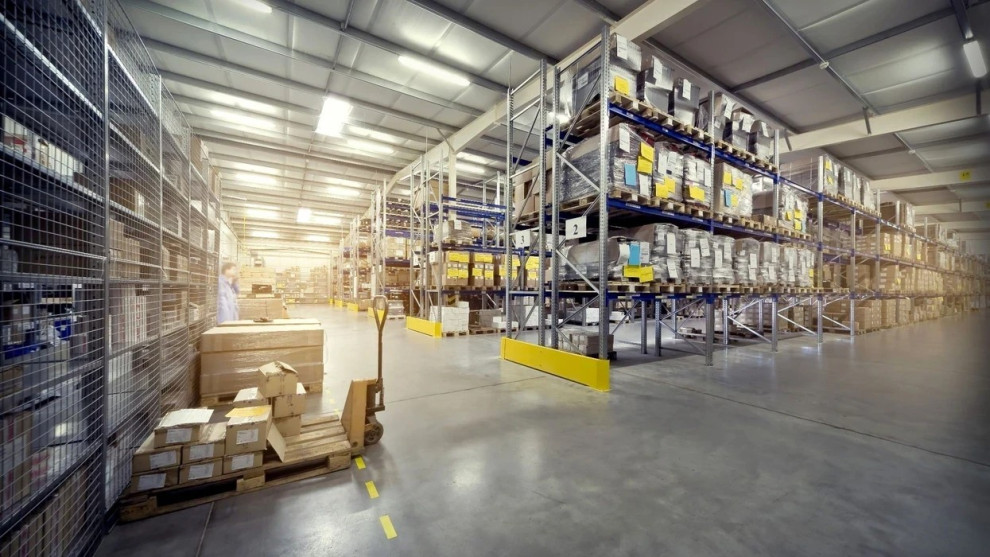Warehouse real estate in Ukraine continues to show resilience and growth potential despite the challenges posed by the war. The forecast for 2025 points to further market recovery.
Western regions and the Kyiv region remain the most attractive for investors seeking stable returns. Class A warehouse facilities in key logistics hubs are considered the optimal choice.
How much does it cost to build a warehouse in Ukraine? What kind of returns can investors expect? Who drives demand in the market, and what is the entry threshold for investors? LIGA.net explored these questions.
War-Driven Changes in Investment
Since the start of Russia’s full-scale invasion in 2022, Ukraine’s warehouse real estate market has experienced major disruptions. According to CBRE Ukraine, investments in warehouse assets dropped by 60% in 2022 compared to the pre-war year of 2021, primarily due to the suspension of most development projects and capital outflows. The hardest hit were Class B and C facilities, which lost up to 70% of their investment inflows, while Class A retained relative stability, driven by demand from international logistics and retail companies.
“In 2022, the market essentially froze due to security risks. However, by 2023, we observed renewed interest in Class A warehouses, particularly from international retailers who had adapted to new logistics realities,” said Nataliia Sokyrko, Head of Industrial and Logistics at CBRE Ukraine, in a comment to LIGA.net.
In 2023, the market began to recover: according to LIGA.net estimates, the total volume of investments increased by 25% compared to 2022. Class A assets accounted for about 60% of total investment, Class B for 30%, and Class C for only 10%.
According to CBRE Ukraine, the warehouse market in Kyiv posted a record absorption volume in 2024—reaching 167,000 sq m, which is 63% higher than in 2023. This reflects renewed interest in Class A and B facilities, while Class C assets remain less attractive due to outdated infrastructure and low energy efficiency.
Last year, the wholesale and retail trade sector dominated gross absorption, accounting for 67%—an increase of 33 percentage points compared to the previous year. Logistics companies, or so-called 3PL operators, followed with a 17% share. However, their contribution to gross absorption decreased by 19 percentage points during 2024.
“The decline in 3PL operator activity was likely due to the fact that most players had already secured sufficient warehouse space in previous years, reducing the need for new lease agreements in 2024,” the CBRE Ukraine report explains.
Nevertheless, by the end of Q1 2025, 3PL operators had become the main drivers of leasing activity in the Kyiv region, accounting for 48% of gross absorption. Meanwhile, wholesale and retail operators contributed 24% of demand. According to CBRE Ukraine, gross warehouse absorption in Q1 amounted to approximately 27,500 sq m, which is 28% lower compared to the same period last year.
Interestingly, the pharmaceutical sector has increased its share of total warehouse space absorption between 2022 and 2024. Prior to that, during 2019–2021, it was barely present in the leasing structure.
“In recent years, the pharmaceutical sector has entered the market more actively for a number of reasons. One of them is that pharmacies began leasing space directly. Previously, this was done by distributors or pharmaceutical logistics companies. Now, the pharma industry holds a share of around 12–13% of the traditional market,” noted Nataliia Sokyrko.
Key Drivers of Warehouse Market Development
During Russia’s full-scale invasion of Ukraine, the dynamics of the warehouse real estate market were shaped by several key factors:
2022: Security risks, infrastructure damage (including 364,000 sq m of warehouse space destroyed in Kyiv region), and the relocation of businesses to western regions led to a sharp decline in investment. Supply chain disruptions also suppressed demand for Class B and C facilities.
2023: Economic stabilization, growing demand from e-commerce, and the relocation of businesses to western and central regions contributed to market recovery. Government support programs such as “5-7-9%” stimulated the development of new Class A facilities.
2024: Rising consumer activity, the return of international brands, and sustained demand from logistics operators pushed warehouse absorption to record levels. However, rising construction costs and energy supply disruptions slowed the development of Class B and C projects.
“The energy crisis in 2024 became a serious challenge but also fueled demand for energy-efficient Class A and B warehouses. Investors started favoring properties with modern energy-saving systems, including those connected to alternative energy sources, which help reduce operating costs,” explained Oleksii Oleinikov, Managing Partner at investment company InVenture, in a comment to Liga.net.
Regional Specifics of Warehouse Real Estate Development
In 2024, the highest level of activity in Ukraine’s warehouse real estate market was observed in the western and central regions. According to CBRE Ukraine, the regions of Volyn, Ivano-Frankivsk, Lviv, Ternopil, and Vinnytsia emerged as investment hubs due to their relative safety, developed infrastructure, and the relocation of businesses.
Lviv region leads in the volume of new warehouse projects, accounting for around 35% of new construction. Despite significant destruction, Kyiv region retains a substantial market share (40%) thanks to the restoration of key logistics nodes. Meanwhile, eastern regions like Dnipropetrovsk are seeing a decline in activity due to proximity to the front line.
“Lviv and Kyiv regions remain key hubs due to their location and infrastructure. At the same time, we are seeing growing interest in Vinnytsia region, which is becoming a new logistics center for central Ukraine,” explained Nataliia Sokyrko.
There is also a noted decrease in investor interest in some assets in western Ukraine.
“Kyiv and the Kyiv region remain the most promising areas for investment in warehouse real estate. Currently, they have the highest demand and supply of logistics properties. One interesting opportunity is a 4.5-hectare land plot with ongoing construction of a 20,000 sq m industrial-warehouse complex. After the first wave of business relocation in 2022—when companies were actively seeking production and warehouse space in western Ukraine—we’ve seen a reversal of that trend since 2023. For example, many investors who acquired logistics assets in Lviv region are now being forced to sell them at a discount due to shifting business needs,” noted Oleksii Oleinikov.
In Khmelnytskyi region, according to data from the State Statistics Service of Ukraine, there is a dynamic pace of new warehouse space being put into operation. Several successful projects are underway in the area, particularly along the Khmelnytskyi bypass road near the Epicentr shopping center.
“In this region, we also have a promising frontage land plot of 6.5 hectares designated for the development of a logistics complex with a total area of over 20,000 sq m. Its location in the central part of the country, along the Khmelnytskyi bypass road, close to the airport and neighboring warehouses of Epicentr, Nova Poshta, and ATB, makes it an attractive opportunity for developers. As of today, we already have two potential tenants willing to lease the entire space at market rates—or even consider purchasing the facility,” shared Oleksii Oleinikov.
It is worth noting that the commonly accepted classification of warehouse properties used in the industry is the result of agreements among consulting firms and is not regulated by the state. Meanwhile, the data from the State Statistics Service mostly covers non-classified properties listed under “industrial and warehouse buildings commissioned or under initial construction.” As warehouse buildings dominate this category, the statistics provide a general picture of regional warehouse construction activity.
Warehouse Construction Costs in Ukraine
The cost of building warehouse facilities in Ukraine varies depending on the class of the facility and the region. According to Liga.net estimates based on open-source data, the average construction costs for warehouses in 2024 were approximately as follows:
Class A: $600–800 per sq m. The high cost in this category is due to the use of modern materials, energy-efficient technologies, and automated systems.
Class B: $400–550 per sq m. These warehouses offer basic infrastructure but often require additional investment for modernization.
Class C: $250–350 per sq m. This is the most budget-friendly segment, comprising older buildings with minimal amenities.
According to the State Statistics Service of Ukraine, the cost of constructing non-residential buildings in the country increased by 27.7% in hryvnia terms between December 2023 and December 2024. Construction costs are expected to rise by another 15–25% in 2025 due to inflation, and the rising prices of energy and construction materials.
“This is why we are currently seeing increased demand in Ukraine for the purchase of completed warehouse properties. For buyers, it is a window of opportunity to acquire finished assets at prices significantly below construction costs and to save time. For sellers, it is a chance to offload relatively illiquid real estate during wartime. Over the past 12 months, InVenture has facilitated seven transactions involving the purchase and sale of industrial and warehouse complexes,” said Oleksii Oleinikov.
Warehouse Real Estate Developers in Ukraine
Approximately 30 major development companies are active in Ukraine’s warehouse real estate market, with 10–12 of them considered key players. These include Dragon Capital, Alterra Group, and Budhouse Group, as well as international firms such as Prologis and Panattoni, which have recently begun to view Ukraine as a promising market. In recent years, Dnipro-based Alfa Development Group has become particularly active, currently developing three projects in the Kyiv region.
Local companies are primarily focused on projects in western Ukraine, while international developers are investing in Class A warehouses near Kyiv and Lviv. According to NAI Ukraine, 70% of new projects in 2024 were implemented by companies with Ukrainian capital.
Drivers of Demand for Warehouse Real Estate
Demand for warehouse real estate across various regions of Ukraine is shaped by the following factors:
Western regions: Business relocation, growth in e-commerce, and security advantages drive demand for Class A and B warehouses. Logistics hubs in Lviv and Ivano-Frankivsk attract international retailers.
Kyiv region: High demand from logistics operators and distributors resuming operations in the area. Class A facilities dominate due to the need for modern, automated warehouses.
Central regions: Demand is rising among local manufacturers and agricultural companies that require Class B warehouses for product storage.
Eastern regions: Demand is declining due to security risks, though there remains a need for Class C warehouses for temporary storage.
Investment effectiveness in warehouse real estate depends on the liquidity of the asset, its location, and demand. The most attractive opportunities are Class A warehouses in Lviv and Kyiv regions, where rental rates grow by 5–7% annually.
“Investments in Class A warehouses in western regions are the most justified in terms of stable demand, high liquidity, and lower regional risks. However, investors should consider rising construction costs, which could impact project returns,” emphasized Oleksii Oleinikov.
As for the capital region, Alterra Group experts note that development activity remains strong on both banks of the Dnipro River—though there are some nuances.
“In Kyiv, we see a shortage of warehouse space on the right bank—vacancy there is as low as 2%. On the left bank, the situation is the opposite: vacancy is twice as high, ranging from 4–6%. On average, vacancy across Kyiv is about 3.5%,” Alterra Group explained.
The company also notes an active transformation of the Lviv warehouse market.
“Soviet-era facilities are gradually disappearing, replaced by new developments. For example, some developers are converting former industrial zones into residential complexes. Prices for outdated warehouse premises already exceed $5 per sq m. By comparison, the average rate for our modern projects is $6.5 per sq m. So, for an extra $1.5, tenants get modern spaces with high-quality infrastructure,” the company stated.
Investment Yields in Warehouse Real Estate
Liga.net calculated the investment yields for warehouse properties of classes A, B, and C based on consulting firm reports and publicly available data. The income capitalization method (cap rate), a standard tool in commercial real estate, was used in the analysis.
According to the calculations, average U.S. dollar returns vary depending on the facility’s class and regional location. The highest yields are typically generated by Class A properties located in major logistics hubs such as Kyiv and Lviv:
Class A: 8–10% annually in Kyiv and Lviv regions; 6–8% in central regions. High yields in this segment are driven by stable demand and long-term lease contracts.
Class B: 6–8% in western regions; 5–6% in central regions. Returns are lower due to higher modernization costs.
Class C: 4–5% across all regions. Yields are limited by outdated infrastructure and short-term leases.
Meanwhile, Alterra Group estimates returns on its projects at 10–12% annually in USD.
“Our pricing model is based on the project implementation stage. The lowest price is offered at the announcement stage, and it increases as the project progresses. Therefore, the earlier the investor enters the project, the higher the yield they receive,” said Hennadii Hrynenko, Commercial Director of Alterra Group, at the end of last year.
When calculating returns, Alterra Group does not factor in property capitalization. Instead, it focuses on investment payback, which begins 11 months after the investor enters the project.
By comparison, the maximum interest rate on U.S. dollar bank deposits in Ukraine currently stands at 3% annually. Meanwhile, inflation in the hryvnia is projected by investment firm ICU to reach 7.8% in 2025 and 8% in 2026.
Forecasts and Risks for Warehouse Real Estate Investment
Experts anticipate continued recovery in the warehouse real estate market in 2025. According to CBRE Ukraine, gross absorption of space is expected to increase by 10–15% compared to 2024, while new construction in the Kyiv region alone is projected to reach 150,000–200,000 sq m, 70% of which will be Class A properties. Rental rates are expected to stabilize, and investment volumes may grow by 20% due to the return of foreign capital.
“In 2025, we anticipate rising demand for Class A warehouses, especially in regions with well-developed infrastructure. Investors are increasingly opting for facilities with high levels of automation and energy efficiency,” forecasts Nataliia Sokyrko.
Demand for Class C warehouses is expected to remain low, as these properties no longer meet modern requirements. Meanwhile, the highest demand for warehouse real estate is projected in the following regions:
- Lviv region: Class A warehouses for e-commerce and international retailers
- Kyiv region: Modern Class A logistics complexes for distributors
- Vinnytsia and Ternopil regions: Class A and B warehouses for agricultural enterprises and local manufacturers
“Many clients who had to downsize their operations in 2022–2023 are now planning to scale back up. The vacated spaces have already been occupied by other companies, so now, in 2025, both groups are looking for new space to support their growth. In many cases, the requirement is an additional 10,000–20,000 sq m—and finding that kind of volume is not easy. That’s why companies are actively returning to the market, searching for modern facilities or developments currently under construction,” noted representatives of Alterra Group.
The company also expects continued growth in rental rates and a decline in vacancy.
“By the end of the year, the average vacancy rate in Kyiv is likely to fall to around 2.5%. Rental rates will gradually increase, reaching approximately $6 per sq m (excluding VAT and OPEX),” Alterra Group predicts.
According to Alterra Group experts, there are currently no major risks of market oversaturation in the warehouse segment—even in high-activity regions like Kyiv and Lviv.
“We estimate the potential for total market expansion to reach up to 10 million sq m in Kyiv and Lviv combined,” the company stated.
For comparison, the State Statistics Service of Ukraine reported that, at the end of last year, warehouse and industrial properties in the early stages of construction amounted to 2.3 million sq m. All of these could be delivered to the market over the next 2–3 years.
Security Remains the Biggest Challenge for Investors. According to estimates by Nataliia Sokyrko, approximately 450,000 sq m of warehouse space were removed from the market due to Russian attacks in 2022–2023. From the beginning of this year through mid-April, an additional 25,000 sq m were damaged or destroyed.
Investment Entry Threshold
Currently, there are no instruments in Ukraine that allow retail investors to enter the warehouse real estate segment with contributions in the range of $10,000–50,000. For example, Altera Group, which offers a syndicated financing model, is willing to work with a minimum investment starting at $130,000.
“If there were an accessible instrument on the market that enabled retail investors to allocate small amounts of capital into warehouse properties—followed by leasing and profit distribution managed by a professional and reputable management company—such a product would enjoy significant demand,” believes Oleksii Oleinikov.
In practice, this could be implemented through a pool of investors using joint investment institutions (JIIs) to buy shares and become co-owners of real estate assets. In such cases, asset management would be handled by an asset management company (AMC).
There are two primary types of investment funds in Ukraine:
- Mutual investment funds (PIFs) – issue investment certificates;
- Corporate investment funds (CIFs) – operate as joint-stock companies and raise capital through the issuance of shares.
“For mutual funds (PIFs), there is no formal entry threshold—you can invest even a few thousand hryvnias. However, the main obstacle is low investor confidence in AMC-issued investment certificates. In the case of venture CIFs, where the investor becomes a shareholder in the legal entity (the fund), the minimum investment check must exceed the equivalent of 1,500 minimum monthly wages,” explained the Managing Partner of InVenture.
Legislators are now taking steps to simplify access to collective investment instruments. In early May, the Verkhovna Rada registered Draft Law No. 13246 on investment funds, which proposes establishing a legal framework for the operation of investment funds in accordance with European Union regulations.
The bill’s authors believe that its adoption will establish the legal and organizational foundations for the creation, operation, and termination of investment funds that comply with European practices and standards. This, in turn, is expected to expand capital-raising opportunities by introducing transparent rules in the investment sector and enhancing investor protection.






